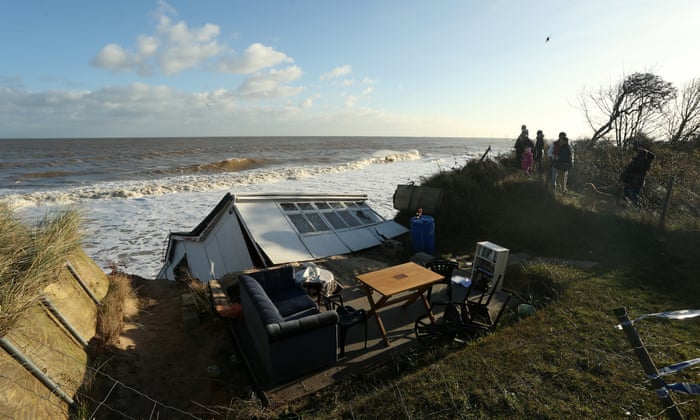Environment Agency calls for urgent action to protect country from river and coastal floods


Entire communities might need to be moved away from coasts and rivers as the UK takes urgent action to prepare for an average global temperature rise of 4C, the Environment Agency warned.
The agency said on Thursday that difficult decisions would have to be taken in the coming years to make sure the UK was resilient amid flooding that would not be held back by higher land defences.
Emma Howard Boyd, chair of the agency, set out the regulator’s long-term strategy for tackling flooding and coastal change, which, she said, was a preparation for a 4C rise in global temperatures. The rise is far in excess of the target of 1.5C above pre-industrial levels set in the legally binding Paris Agreement of 2015.
“The coastline has never stayed in the same place and there have always been floods, but climate change is increasing and accelerating these threats,” said Howard Boyd. “We can’t win a war against water by building away climate change with infinitely high flood defences. We need to develop consistent standards for flood and coastal resilience in England that help communities better understand their risk and give them more control about how to adapt and respond.”
The strategy text says the approach to flood protection a
“Resilience includes accepting that in some places we can’t eliminate all flooding and coastal change, and so we need to be better at adapting to living with the consequences – for example, by designing homes that can be restored quickly after they’ve been inundated with water, or potentially moving communities out of harm’s way.”
It is already thought unbeneficial to protect or adapt about 114 miles of coastline because of flooding, and more than 1,000 miles of coast are at risk of erosion.
A recent report from the government’s advisory panel the Committee on Climate Change said that by the 2080s up to 1.5m properties in England could be in areas of significant levels of flood risk.
In the Humber estuary rising sea levels and river flooding are putting 55,000 homes at risk. In 2013 a tidal surge hit the east coast, forcing thousands of people to abandon homes as areas of the North Sea rose to higher levels than had happened in the floods of 1953. In Devon, in 2014, people were forced from their homes and a key stretch of the railway link to the rest of the UK was destroyed in storms and flooding.
nd assessing risk had to change. “We need to act now without delay … we need to apply a different philosophy.”
Instead of acting once a flood had happened the country needed to build “climate resilient” communities, homes and businesses, and simply building bigger and bigger walls as defences was not the solution, the document says.
The policy calls for natural barriers and flood relief systems, but also for an increase in the resilience of homes and businesses against the inevitable flooding with such structures as flood doors and stone floors.
The strategy also makes clear that some areas of the UK and some homes and businesses cannot be protected. “Despite our collective best efforts, we will not always be able to prevent flooding and coastal change happening.” The priority in these areas will be to keep people safe, minimise damage and aid quick recovery. Ultimately it may also mean supporting individuals and communities in a move from an affected area.
More homes would be at risk in the future as the number of properties built on floodplains was likely to double over the next 50 years, the agency warns.
The agency set out a target, for up to 2050, for the UK to become resilient to flood and coastal risks, and for a policy of “resilience for places”, referring to the ability of communities to cope with, and recover from, all sources of flooding or coastal change.
The agency says an average outlay of £1bn a year will be needed to build traditional flood and coastal defences and allow for natural flood management.
“Flooding of any kind is horrendous,” the report says. “Erosion destroys. [Floods] are dirty, invasive, damaging, and can kill. They can force people to leave their homes and their businesses, cause prolonged mental ill health, and destroy livelihoods, natural habitats and other valued places. At best flooding and coastal change can be inconvenient and disruptive.”
Lord Deben, chair of the Committee on Climate Change, last week called for the British government to immediately set a legally binding target to cut greenhouse gas emissions to zero by 2050. He said the UK urgently needed to stay ahead of worsening impacts by adapting. “The Environment Agency is doing just that by setting out their flood strategy, but we won’t be able to keep up with the pace of change if we don’t reduce emissions to zero,” he said.
Mike Childs, head of science at Friends of the Earth, said smarter adaptation and building resilience to flooding was undeniably important but that the focus should be first and foremost on slashing emissions to avoid the worst consequences of climate chaos.
“With its relentless pursuit of fracking, airport expansion and road building, and barely tepid support for renewable energy, our government is failing with this regard,” Childs said.
The environment minister, Thérèse Coffey, said the government was already providing £2.6bn over six years, delivering more than 1,500 projects to better protect 300,000 homes. “But the threat of climate change will mean an increasing risk, and preparing the country is a priority for the government, and the nation as a whole,” she said, adding that the government would be launching a call for evidence to inform action on flood and coastal erosion risks.
The Guardian, 9 May 2019

No hay comentarios:
Publicar un comentario